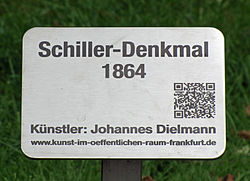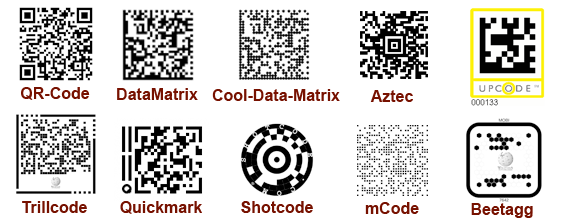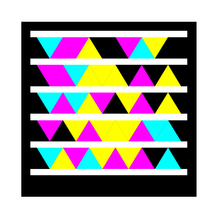Mobile tagging
Mobile tagging is the process of providing data read from tags for display on mobile devices, commonly encoded in a two-dimensional barcode, using the camera of a camera phone as the reader device. The contents of the tag code is usually a URL for information addressed and accessible through Internet.

History
[edit]Mobile tagging is currently most prominent in Asia, especially Japan. It was developed in 2003 and ever since it has been used in several fields of mobile marketing. Denso's QR Code

in Asia and the Data Matrix are currently the most popular 2D barcodes. Both are ISO-standardised. In 2009, prominent electronics company Microsoft introduced the Microsoft Tag format, based on the company's self-developed High Capacity Color Barcode (HCCB) standard, in an effort to establish the format through emerging mobile tagging markets in the west.[1] Unlike most popular 2D barcodes, which use black-and-white square pixels, HCCBs are based on colors in a triangle-based arrangement.
The reason for the success of mobile tagging, besides the flexible and multiple fields of application, is the quick, precise and customer-driven access to information. According to the principle of physical world connection (see also Object hyperlinking), the user is able to gather digital information immediately by scanning a two-dimensional barcode, like one on an advertisement.
In Europe mobile tagging is now gaining traction, albeit that the primary usage has been direct linking of URLs to 2D codes. Indeed, several campaigns in relation to physical world connection have been launched, however a standard for multi-dimensional barcodes is still missing.
One of the key organizations driving wider implementation of two-dimensional barcodes is GS1 / GS1's main activity is the development of the GS1 System, a series of standards designed to improve supply chain management. The GS1 System is composed of four key product areas: Barcodes (used to automatically identify things), eCom (electronic business messaging allowing automatic electronic transmission of data), GDSN (Global Data Synchronisation Network which allows partners to have consistent item data in their systems at the same time) and EPCglobal (which uses RFID technology to immediately track an item).
Codes and readers
[edit]

Currently about 70 different types of barcodes and their specific versions exist and are mostly in use in the field of logistics. In terms of mobile tagging, the number of codes is essentially restricted to a dozen types. For reading out 2d-barcodes it is essential to install specific software, a reader, on the mobile device.
The reader uses the camera of a mobile phone for the mobile tagging process. The producers of the reader are very involved in developing solutions to increase the number of compatible mobile phones. Most services on the corresponding websites offer the download directly onto the mobile device or PC. In addition, many providers offer the user a generator for creating their own codes.
Smartphone cameras can be used in Google's mobile Android operating system via both their own Google Goggles application or 3rd party mobile tag readers. Nokia's Symbian operating system features a scanner which can scan mobile tags,[2] while mbarcode[3] is a reader for the Maemo operating system. In the Apple iOS, a mobile tagging reader is natively included in the iOS 11 update through the camera app, although there are more than fifty paid and free apps are available with both scanning capabilities and hard-linking to URI. With BlackBerry devices, the App World application can natively scan mobile tags. Windows Phone 7.5 is able to scan tags through the Bing search app.
Due to the absence of a standard code, the readers are faced with the same problem. On the one hand there is a remarkable number of readers which aren't able to identify barcodes apart from their own proprietary codes. On the other hand, there are several readers which were created to read out non-proprietary code, these 'open source codes' are the most used for Optical Reading with Mobile like the QR Code and the Data Matrix. However, a QR code is always 60% larger than a DataMatrix code and this tends to mean that DM is the primary code used in packaging and enterprise solutions for example.
Application areas
[edit]At present, mobile tagging is not only finding its way into the day-to-day-life of campaigns in the fields of commercial, public and private tagging but also may end absolute convergence between information media. Mobile tagging connects static information carriers with the Internet and encourages the interactive behaviour of the user. At least this is not the only reason why leading experts are firmly convinced that performance in the European markets will almost reach Asian levels in the foreseeable future. However, the future success will not be attributed to simply linking to URL's, as with the internet no one will pay to connect to a URL. The real enterprise solutions are where the codes will be monetized and customization for business and commercial use will be at the forefront of intelligent and professional use, examples of which are; e-government, tourism, advertising and targeted marketing, packaging, supply chain management, brand management and brand protection, logistics, track and trace, anti-counterfeit or smuggling, id & passports, transport and ticketing, parking, disability, CRM, cross media campaigns, m-ticketing, m-payments, e-learning, complete integration of localization, personalization, objects and other data.
Commercial tagging
[edit]Commercial tagging includes the use of multi-dimensional barcodes, especially in the fields of mobile marketing and advertising. Showcases in this context are additional information on products (such as the nutrient content on hamburgers), direct downloads such as free ringtones, clips or mobile games) and the direct link to a specific site of a company. Particularly in the field of commercial tagging it is vital for the code to be able to be branded (it is possible to integrate a logo in the code). It is hard to convince people to use this technology.
The first company used QR Code for IT Asset Inventory Tagging System was initiated last October 11, 2012 made by Castlewood Group Pte Ltd Singapore led by IT Manager, Engr. Men-She-Vik P. San Diego, MIT. This unique concept innovates the use of QR Code as a medium for proper handling and monitoring of IT devices and peripherals for this company. Earlier concept made by other companies with the help of bar code tagging technology for IT asset inventory but now with the latest technology of encrypting and decrypting of information, QR Code may consider as one of the best application to manage IT asset of the company.
Public tagging
[edit]In terms of public tagging, barcodes serve as a hyperlink to additional information on public information carriers. This information may include maps, customer reviews or other non-commercial advice.
Private tagging
[edit]In view of private tagging, personal motives come to the fore. Besides the opportunity for creating direct hyperlinks on blogs or profiles, it is possible to participate immediately in online auctions (such as barcodes on cars with eBay hyperlinks).
Furthermore, barcodes allow services like saving data automatically in the contact list of mobile phones by scanning a code printed on business cards.
In addition to higher user friendliness, private tagging offers novel opportunities for self-presentation.[original research?]
See also
[edit]References
[edit]- ^ Acohido, Byron (2009-05-19). "New '2D barcodes' puts info at the tip of your camera phone". USA Today. Gannett Company. Retrieved 31 July 2009.
- ^ "Nokia Europe – Nokia N80 – Support".
- ^ "package overview for mbarcode". Maemo.org. Retrieved 28 July 2010.
